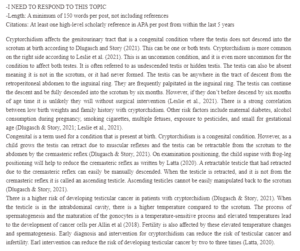The Ideal Timing for Correcting Orchidopexy
Jody,
Thank you for sharing your post. The ideal timing for correcting undescended testes through surgery, also known as orchidopexy, has been considered in different fora and which have resulted in a wide range of consensus guidelines and statements. These statements and guidelines state that orchidopexy should be performed ideally when a child is between the ages of 6 months and 12 months and at the very latest at 18 months (Radmayr et al., 2016). Cho et al (2019) cite these guidelines in a more recent Practice Pointer on the undescended testis investigation and management. The authors assert that the recommended surgery by the international guidelines is between 6 months and 18 months of age. Elder et al., (2016) adds that with orchiopexy, patients are now able to get a permanent solution from the previous alternatives. Initially, children were left untreated and sometimes put on a trial of hormonal therapy or orchiectomy. However, the presence of a testis in the scrotum may not be of any benefit for some patients where the procedure neither enhances fertility nor reduces malignancy. A prosthesis, on the other hand, may offer psychological support and comparable appearance (Elder, 2016). There is no treatment that is indicated in cases where the patient has an ejaculatory failure (such as prune belly syndrome), severe mental retardation, and particular endocrine syndromes. Hormonal therapy can aid in cases of bilateral prepubertal patients and may also be beneficial in certain endocrine disorders (Elder, 2016). Orchiectomy has been indicated for unilateral cases for persons with severe neurogenic disturbances that in prepubertal patients with one abdominal testis and also in post-perbutal patients with unilateral cryptorchidism occurring at any site, preclude ejaculation. When assessing risk versus benefits, the best option for the patient should be implemented. Get in touch with us at eminencepapers.com. We offer assignment help with high professionalism.
References
Cho, A., Thomas, J., Perera, R., & Cherian, A. (2019). Undescended testis. Bmj, 364.
Elder, J. S. (2016). Surgical management of the undescended testis: recent advances and controversies. European Journal of Pediatric Surgery, 26(05), 418-426.
Radmayr, C., Dogan, H. S., Hoebeke, P., Kocvara, R., Nijman, R., Stein, R., … & Tekgul, S. (2016). Management of undescended testes: European Association of Urology/European Society for Pediatric Urology guidelines. Journal of Pediatric Urology, 12(6), 335-343.
ORDER A PLAGIARISM-FREE PAPER HERE
We’ll write everything from scratch
Question
-I NEED TO RESPOND TO THIS TOPIC
-Length: A minimum of 150 words per post, not including references
Citations: At least one high-level scholarly reference in APA per post from within the last 5 years

The Ideal Timing for Correcting Orchidopexy
Cryptorchidism affects the genitourinary tract that is a congenital condition where the testis does not descend into the scrotum at birth according to Dlugasch and Story (2021). This can be one or both tests. Cryptorchidism is more common on the right side according to Leslie et al. (2021). This is an uncommon condition, and it is even more uncommon for the condition to affect both testes. It is often referred to as undescended testis or hidden testis. The testis can also be absent meaning it is not in the scrotum, or it had never formed. The testis can be anywhere in the tract of descent from the retroperitoneal abdomen to the inguinal ring. They are frequently palpitated in the inguinal ring. The testis can continue the descent and be fully descended into the scrotum by six months. However, if they don’t before descend by six months of age time it is unlikely they will without surgical intervention (Leslie et al., 2021). There is a strong correlation between low birth weights and family history with cryptorchidism. Other risk factors include maternal diabetes, alcohol consumption during pregnancy, smoking cigarettes, multiple fetuses, exposure to pesticides, and small for gestational age (Dlugasch & Story, 2021; Leslie et al., 2021).
Congenital is a term used for a condition that is present at birth. Cryptorchidism is a congenital condition. However, as a child grows the testis can retract due to muscular reflexes and the testis can be retractable from the scrotum to the abdomen by the cremasteric reflex (Dlugasch & Story, 2021). On examination positioning, the child supine with frog-leg positioning will help to reduce the cremasteric reflex as written by Latta (2020). A retractable testicle that had retracted due to the cremasteric reflex can easily be manually descended. When the testicle is retracted, and it is not from the cremasteric reflex it is called an ascending testicle. Ascending testicles cannot be easily manipulated back to the scrotum (Dlugasch & Story, 2021).
There is a higher risk of developing testicular cancer in patients with cryptorchidism (Dlugasch & Story, 2021). When the testicle is in the intrabdominal cavity, there is a higher temperature compared to the scrotum. The process of spermatogenesis and the maturation of the gonocytes is a temperature-sensitive process and elevated temperatures lead to the development of cancer cells per Allin et al (2018). Fertility is also affected by these elevated temperature changes and spermatogenesis. Early diagnosis and intervention for cryptorchidism can reduce the risk of testicular cancer and infertility. Earl intervention can reduce the risk of developing testicular cancer by two to three times (Latta, 2020).
Reference
Allin, B. S. R, Dumann, E., Fawkner-Corbett, D., Kwok, C., & Skerritt, C. (2018). Systematic
review and meta-analysis comparing outcomes following orchidopexy for cryptorchidism
before or after 1 year of age. BJS Open, 2(1), 1-12. https://dx.doi.org/10.1002/bjs5.36
Dlugasch, L., & Story, L. (2021) Applied pathophysiology for the advanced practice nurse.
Jones & Bartlett Learning.
Latta, K. (2020). Infant testicular torsion with cryptorchidism case study. Urologic Nursing,
40(6), 295-298. https://doi.org/10.7257/1053-816×2020.40.6.295
Leslie, S. W., Sajjad, H., & Villanueva, C. A. (2021). Cryptorchidism. STATPearls.
https://www.ncbi.nlm.nih.gov/books/NBK470270/.
Venkataramappa, S., Chikkannaiah, P., Lalyanayak, P. K., & Rao, S. (2016). Ossifying
seminoma arising from cryptorchid testis masquerading as acute abdomen. Journal of the Scientific Society, 43(1), 51-53. https://doi.org/10.4103/0974-5009.175465

